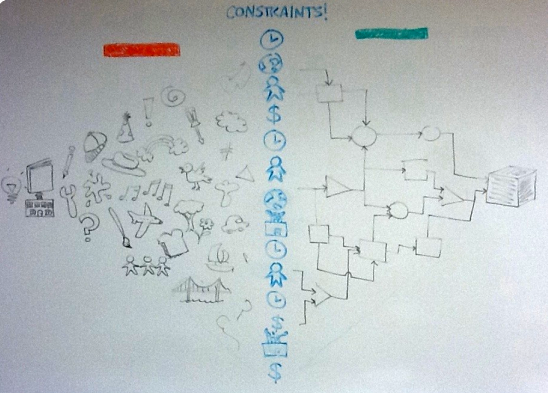Why is there a bird and a PBJ sandwich in our picture of engineering thinking?
Answer: why not?
"What is engineering thinking?" asked Prof. Demetra Evangelou on the first day of our Theories of Development and Engineering Thinking class (henceforth abbreviated as "Thinking"). "Draw a picture." So Farrah, Tosin, and myself came up with this, inspired partially by our History and Philosophy of Engineering Education class last fall (henceforth abbreviated as "H&P").
It's missing the disclaimers we added later, which are "NOT DRAWN TO SCALE" and "WARNING, IMPERFECT MODEL" - but it'll suffice. We wanted to illustrate tensions and cycles, creativity and constraints, and intended this to be a loop - time moves from "idea!" on the left to "solution!" on the right, but there's also an arrow that swings back from the black box (solution) at the end back to the lightbulb (idea) on the right.
As engineers, we dream all sorts of dreams, synthesize so many things from all over - school, books, other people (collaboration runs rampant in the field), music, nature, dreams, art, other disciplines, history - and yes, birds and peanut butter sandwiches. We have the privilege of dreaming and the responsibility of implementation; it's an engineer's job to make dreams real, and reality imposes some constraints. You can see those in blue across the middle; manpower, available skills and resources, money, time, environmental factors, and so forth. And then the right side displays the analytical side (which is, in my opinion, necessary but overemphasized in most engineering programs) - quantifying, neatening, narrowing down, analyzing, optimizing... until - solution, usually not because it's truly done and satisfactory, but because we have to ship now.
Tshirt idea: ENGINEERS - MAKIN' IT REAL.
We had some fascinating discussions in the meantime. Tosin proposed that engineering thinking was "cynical" - you're trained to be a little skeptical of everything, wary, running worst-case scenarios because lives may depend on your solutions. Francesca found words to describe the struggle of balancing subjectivity with objectivity. I argued that engineering thinking in practice was completely different from engineering thinking in theory: there's what we tell our students and write in our textbook, and then there's what we actually do when we walk out of the classroom and roll up our sleeves.
The other groups came up with diagrams with disembodied heads, babies, funnels, wheels... we're having a good time. (And then Prof. Evangelou assigned this week's readings and everybody's eyes widened slightly in panic at the sheer volume of material - but we'll survive.)
